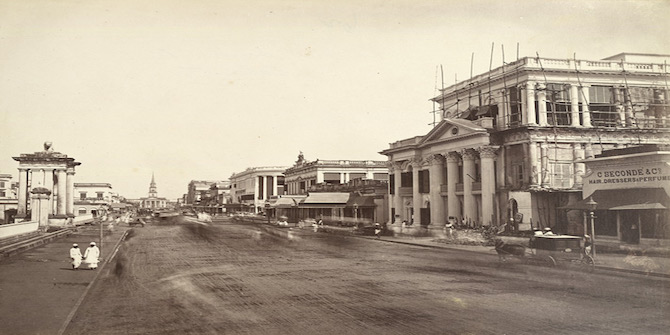Following the arrest of five Indian civil rights activities under the Unlawful Activities (Prevention) Act in August 2018, Emily Rook-Koepsel (University of Pittsburgh, USA) looks back at the creation and use of the Public Order Acts in India to argue how their use in contemporary India isn’t too dissimilar to their use when India was under colonial rule.
In late August 2018, five Indian civil rights activists were arrested under the Unlawful Activities (Prevention) Act (UAPA) for activities connected to a Dalit rally called the Bhima Koregaon in Maharashtra and the subsequent clashes between Hindu nationalists and the Dalit crowd. Although at the time police blamed the violence on the rowdy Hindutva supporters, as the central government became more involved in the case, blame was shifted onto the Dalit activists and supporters who were organising the event.
In justifying the arrests of the five civil rights activists under the draconian UAPA, the government declared these men and women to be ‘urban naxals’ arguing that their support for and work toward greater access to government was fundamentally destabilising to the state. In short, the government has argued that though dissent against the state is hallmark of democratic government, irresponsible or unruly dissent, especially coming from marginal spaces in the state (both geographically and with regard to power) threatens the coherence of the Indian nation and must be policed.
Actions like the arrest of the five civil rights activists in the summer of 2018 are made possible in India by a series of ‘public order acts’, including acts like the UAPA, the Armed Forces (Special Powers) Act, the Prevention of Terrorism Act, and Terrorist and Disruptive Activities (Prevention) Act, which are premised on the state’s need to ‘keep the public order.’ Each of these ‘acts’ allow the government or its representatives broadly defined power to police populations which in some way threaten or are perceived to threaten the state.
While none of these acts are universally applicable, within specific boundaries of geography, politics, or populations they can operate as nearly unimpeachable; laws unto themselves. It is for this reason that in speaking of the Armed Forces (Special Powers) Act, then Union Minister Kiren Rijiju argued, “no democratic society will want to have such a law,” yet it was necessary to bring irresponsible populations under the governance of state.
The enactment of these order ordinances and their use are premised on two interconnected arguments. First, in order to maintain freedoms for ‘normal’ bodies or groups, marginal bodies or groups have to be surveyed, policed, and punished in an authoritarian manner, and second, ‘responsible’ dissent against the Indian state is underwritten by the person or group’s status as ‘normal’ and the critique being ‘respectful’ of the state.
A short history of Public Order Acts
India has a storied history of broadly defined ‘rules’ and ‘acts’ that assign the state the power to impose order but do it without clear guidelines that define their scope or contestability. Some of the current day ordinances can be traced back to the colonial government of India.
The Armed Forces (Special Powers) Act, which is used primarily to grant near martial law power to the Armed Forces in certain regions of the state designated as ‘disturbed’, is a direct descendant from the Armed Forces (Special Powers) Ordinance of 1942. The 1942 Ordinance was ostensibly a way to protect British India’s eastern border, but was used more frequently as a way to arrest, question and even execute anti-colonial, anti-war activists during World War II and later to detain masses of people during the pre-partition riots in Eastern Bengal.
Public order acts were a staple of the British Indian state. As early as 1812 in Bengal, the British enacted rules allowing for preventative detention on the basis of perceived danger to the province. Acts allowing for draconian action in response to sedition or libel were enacted at the turn of the 20th century. In 1915, in response to a perception of revolutionary nationalist activity in India, the Viceroy’s council passed the Defence of India Act.
The Act was an emergency ordinance with a wide-ranging mandate to ‘secure the public safety of British India’ and only meant to be applicable during the duration of the war. The Defence of India Act touched virtually every speech and movement in India. The Act was used to censor books, newspapers, and later films, to imprison people at will, to ban political organisations, and to deport non-Indian citizens from the subcontinent.
After the war, the government continued to rely on the Defence of India Rules, and when World War II began in 1939, the Defence of India Act was reinforced. After the independence the Defence of India Act, along with several other ordinances like it, was officially revoked in 1947 as one of the first moves by the Constituent Assembly, but its order mechanisms were never fully abandoned, and it has been revived several times during India’s foreign wars.
Press freedom: A case study of dissent and Public Order Acts
One of the most sustained fights against the Defence of India Act came from a somewhat unlikely, and often forgotten source. From 1940 until the early 1950s, a small but influential group of newspaper editors and owners called the All India Newspaper Editors’ Conference waged a resistance against the policing and censoring of the news under Article 41 of the Defence of India Acts. At the start of WWII, several interacting laws policed newspaper content—The Indian Press (Emergency Powers) Act of 1931, the Vernacular Press Act (1878), and the Defence of India Rules article 41.
The Indian Press (Emergency Powers) Act of 1931 was the basis for ‘scrutiny’ or even suppression of anti-colonial newspapers, the Vernacular Press Act was used to attempt to delegitimise non-English writing and the politics that went along with it, and the Defence of India Act placed limits on the kinds of writing permitted about borders and the British Empire.
With the outbreak of World War II, and the ramping-up of anti-colonial agitation, the balance of repression shifted. More and more cases were summarily dealt with using the Defence of India Article 41, making it difficult for newspaper editors to predict what would trigger censorship, and nearly impossible to object to the government’s censorship decisions. As scrutiny increased, and the government began to use Article 41 as a blunter weapon, the press organised to fight not just censorship, but also to retain predictable, even if repressively predictable, press regulation. One of the most consistently stated changes that the All Indian Newspaper Editors’ Conference called for during the twelve years it functioned (1940–1952) was the maintenance of normal legislation rather than order ordinances like the Defence of India Rules in enforcing caps on freedom of the press.
Although the All India Newspaper Editors’ Conference was organised and built upon a platform that emphasised the importance of a completely free press to secure democracy in India, during its active years the leaders of the organisation were primarily focused on finding ways to ensure that the press was able to continue to run and run consistently.
That is to say, the leadership board spent their time working to consistent enforcement of often draconian laws against press freedom. The organisational leadership often argued that it would be better to have consistent enforcement of strict laws and censorship than to have inconsistently enforced censorship, the effect of which distinctly undermined the safety and security of papers outside the mainstream either because of language, geography, or political bent.
As the organised editors argued at their meeting in 1942, held under the shadow of the suspension of several prominent newspapers especially in Bengal, a focus on consistent enforcement of laws meant that pressure could be applied both to the government and the population to support legal change but that support was difficult to muster for capricious judgments based on a claim of the needs of public order. Though the organisation had a difficult time transitioning from a resistance organisation united by their opposition to colonial censorship to an organisation dedicated to policing Indian government policy, their concern about public order acts and the harm they did to marginal actors is still apt today.
When we consider the case mentioned at the beginning of this post of the civil rights activist jailed for unruly dissent against the state, it is useful to note that while the legal and punishment mechanisms involved in holding these activists functions under ‘acts’ that are not easily questionable, the labelling of the accused as ‘urban naxals’ emphasises their space outside the normative citizen, and for the state, their capacity to be held in favour of creating space for the dissent of ‘reasonable’ citizens.
This does not look much different to the colonial government labelling anti-colonial editors and publishers as ‘irresponsible’, rabble, terrorists and liars, shutting their publications and jailing them. The space of the normal, or of the ‘responsible’, is what is defined as Indian and allowed to continue more or less without comment, while marginal groups are policed, also more or less without comment.
This article gives the views of the author and not the position of South Asia @ LSE blog, nor of the London School of Economics. Please read our comments policy before posting. Featured photo: Hammer. Photo Credit: Pixabay, Succo.
Emily Rook-Koepsel is the Assistant Director for Academic Affairs at the Asian Studies Center at the University of Pittsburgh. Her recent book Democracy and Unity in India: Understanding the All India Phenomenon, 1940-1960 considers how minority political organisations pushed to redefine ideas of democracy and unity in India in the decade before and after Indian independence.







